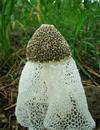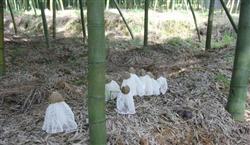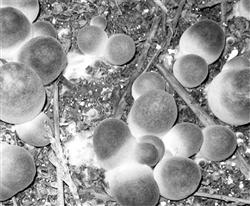Dictyophora planting: what is Dictyophora slime disease?

What is Dictyophora slime mold disease? Please introduce and guide the prevention and control of Dictyophora myxomycosis: Dictyophora slime disease mainly occurs in bare soil or straw covered by Dictyophora border and spreads rapidly. The culture material in the border of Dictyophora harmed by slime mold became moist and rotten, the mycelium growth was affected or gradually died out, and there were a large number of bacteria and nematodes in the culture material, which no longer grew Dictyophora; Dictyophora buds were waterlogged and moldy. The causes of Dictyophora myxomycosis are as follows: first, slime mold is suitable to grow in places rich in organic matter and humid environment under high temperature and humidity. Especially under the condition of high temperature and humidity, it is most beneficial to the germination and growth of myxomycetes spores. The vegetative colonies expand rapidly, which can expand 20cm in one day at most, and cover a large area of border bed in a few days. Second, bacterial slime molds infected by culture materials are omnivorous organisms. Bacteria, organic matter, mycelium fragments and spores of edible fungi are all nutritional sources of slime molds, especially bacteria are good food for slime molds. If Dictyophora culture material or buds are infected by bacteria, myxomycosis is very easy to occur. Third, the soil or water source, air with slime mold. Prevention and control of slime mold of Dictyophora: the prevention and control of slime mold is the same as that of crop diseases, which should be based on the principle of "prevention first and comprehensive control". First, the use of pollution-free, strong vitality of high-quality bacteria. Bacteria should be carefully checked before use, and should not be used for cotton bacteria, which are odorous or too dry, too wet and too old. Second, pay attention to the selection of fields, sun exposure and sterilization in advance. The fields with sunny, ventilated, fertile soil and easy drainage should be selected as the cultivation land of Dictyophora, and the straw roots of the fields should be cleared 20-30 days in advance. The ditches should be cleared and drained around the border, and the ditches should be wide and deep, so as not to silt up Rain Water. In the 7-10 days before cultivation, dichlorvos and carbendazim were sprayed 500 times and 25kg lime was sprinkled per 666m2. One day before the whole bed was sown, the insecticidal and sterilization was carried out again according to the above-mentioned drugs. Third, the treatment of culture materials. The raw materials for the cultivation of Dictyophora must be fully dried, such as sawdust, bamboo shavings, fungus grass, waste fungus, etc. When unloading cultivation, put these raw materials into a pool and soak them in a pool for 36 hours and ferment them in a heap for 7 days. When soaking or composting, add 0.3% calcareous 0.5% lime and 500 times carbendazim in water or material to sterilize. Add 2%-3% bleach when soaking. Fourth, strengthen the management of border beds. Dictyophora should choose a sunny day when sowing, sprinkle some bamboo leaves or covered straw on the border after sowing and cover the soil, and insert arched bamboo sheets to cover the film for heat preservation, moisture and rain protection; sunshades around the mushroom shed should not be too thick, too dense, and should be easy to ventilate; the border ditch should not have Rain Water siltation, the soil humidity should be maintained at 20%-25%, the air relative humidity should reach 80%-90%, and the light should reach 600-800Lx. Fifth, the treatment after the disease. Once slime mold occurs in the Dictyophora border bed, stop spraying water and increase the light and ventilation of the mushroom shed. At the same time, remove the culture material and loam from the affected area, clear it a little wider, and sprinkle lime and fungicides in the cleaning area. At the initial stage of the disease, carbendazim, thiophanate methyl, copper sulfate 1Glux 500 times and 100ml 200 international units of streptomycin or bleach containing available chlorine 150mg/L could be sprayed continuously for 4 times. Click to get more planting techniques of Dictyophora, click to get more planting techniques of edible fungi
- Prev

Dictyophora planting: how to grow Dictyophora in the north?
How to grow Dictyophora in the north? Please introduce the method of planting Dictyophora in the north. Please refer to the following techniques: 1. Site arrangement: select cultivated land with sunny, ventilated, fertile soil and convenient drainage and irrigation. Make border bed, width 1m, height 30cm, length variable; border distance 50cm, border surface covered with fertilizer soil above 10cm, leveling. Of course.
- Next

What's the point of growing straw mushrooms in summer?
What's the point of growing straw mushrooms in summer? Straw mushroom is a kind of edible mushroom cultivated in high temperature season, and it is the fastest harvest of all edible mushrooms. It takes only 10-14 days from sowing to harvesting. The technology is easy to master, low cost and fast, so it is very suitable for greenhouse cultivation in summer. The cultivation of high-stability mushrooms in summer should be.
Related
- Fuxing push coffee new agricultural production and marketing class: lack of small-scale processing plants
- Jujube rice field leisure farm deep ploughing Yilan for five years to create a space for organic food and play
- Nongyu Farm-A trial of organic papaya for brave women with advanced technology
- Four points for attention in the prevention and control of diseases and insect pests of edible fungi
- How to add nutrient solution to Edible Fungi
- Is there any good way to control edible fungus mites?
- Open Inoculation Technology of Edible Fungi
- Is there any clever way to use fertilizer for edible fungus in winter?
- What agents are used to kill the pathogens of edible fungi in the mushroom shed?
- Rapid drying of Edible Fungi

